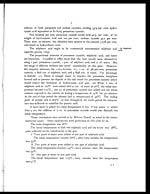Medicine - Institutions > Army health reports and medical documents > Scientific memoirs by officers of the Medical and Sanitary Departments of the Government of India > Number 38 - Preliminary report on the killing of rats and rat fleas by hydrocyanic acid gas > Preliminary report on the killing of rats and rat fleas by hydrocyanic acid gas
(12) Page 4
Download files
Individual page:
Thumbnail gallery: Grid view | List view

4
The end results vary then, not only with the initial temperature developed,
but with the bulk of fluid used. In cold climates, as in the Punjab in the Cold
weather, it would be advisable to mix the various chemicals in one large vessel
rather than distribute them in small charges about a room, as cooling of the
mixture in the latter case would occur so much more quickly.
Considering every point the use of the 1-2-4 formula is probably the best.
A few minor points advocated by various authorities are:—(1) The use of
fairly large lumps of potassium cyanide instead of powdering it. The generation
of the gas is too, violent with powdered potassium cyanide. Further the
powdered salt is apt to deteriorate on standing by exposure to air; and, lastly,
there is the increased cost of powdering the salt. If there is a sufficient excess
of sulphuric acid and water the inter-action of the chemicals is rapid—almost as
rapid with large pieces of potassium cyanide as with small. (F. A. Sirrine, New
York Agricultural Department, 1909.)
The Entomologist of the Cape of Good Hope advocates the use of lumps of
potassium cyanide, the size of an egg for one lb. charges and lumps the size
of an acorn for small charges.
(2) The acid ought to be poured into the water if splattering of the acid
is to be avoided. The potassium cyanide ought to be added last. The
maximum effect of the gas is then produced.
(3) The storage of the potassium cyanide is of importance as under
exposure to air and moisture it deteriorates rapidly. After a case containing
potassium cyanide has been opened means ought to be taken to prevent ingress
of air and moisture. It ought to be kept in a cool dry place. The same
precautions are necessary to keep the sulphuric acid from absorbing moisture.
Methods of carrying out Fumigation recommended by previous
workers.
(I) The quantity of potassium cyanide to be used per cubic space to be
fumigated.
There is some difference of opinion with respect to this point.
Burgess of Ohio in a paper on "Fumigation of Nursery Stock" states:
"A series of experiments in treating peach buds made in August 1902 showed
that s/4 oz. of cyanide to each 100 cubic feet of space for 40 minutes' exposure
killed all San Fose scales and no injury resulted to buds."
Newell of the Georgia State recommends 1 oz. of 98 per cent. potassium
cyanide to 100 cubic feet. With this dosage he states that "trees heavily
infested with the San Jose scales and protected with a heavy layer of earth failed
to show any live scale insects within a year of being fumigated."
Set display mode to: Large image | Zoom image | Transcription
Images and transcriptions on this page, including medium image downloads, may be used under the Creative Commons Attribution 4.0 International Licence unless otherwise stated. ![]()
| Permanent URL | https://digital.nls.uk/75033583 |
|---|
| Shelfmark | IP/QB.10 |
|---|---|
| Additional NLS resources: | |




